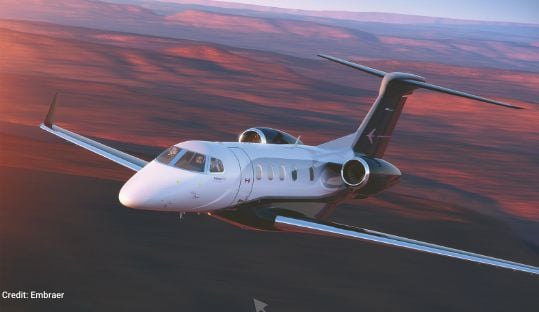Aircraft Overview: Phenom 300E
Aircraft Overview: Embraer Phenom 300E

Phenom 300E
The Phenom 300 and 300E are twin-engine business jets produced by Brazilian manufacturer Embraer that are based on the company’s EMB-505 type.
Announced in 2005, the first flight of an EMB-505 was made on April 29, 2008—a flight which was operated by Serial No. 50599801, registered as PR-XVI—from Gaviao Peixoto, Brazil, ahead of the type being certified by the Brazilian National Civil Aviation Agency [Agencia Nacional de Aviacao Civil (ANAC)] on Dec. 3, 2009.
Following certification, the first delivery of a Phenom 300 occurred on Dec. 29, 2009, to a U.S.-based customer. Embraer subsequently announced the Phenom 300E on Oct. 9, 2017, at the National Business Aviation Association Business Aviation Convention and Exhibition (NBAA-BACE), with the “E” signifying an “enhanced” airframe that has several cabin improvements.
The first Phenom 300E delivery took place on March 29, 2018, to a South African customer, while an improved Phenom 300E—marketed as the Phenom 300E Enhanced—was announced in January 2020, and the first such airframe was delivered to a U.S. customer on June 26, 2020.
According to the ANAC type certificate data sheet (TCDS) for the EMB-505, the type can accommodate up to 11 occupants, with up to 10 passengers able to be carried when the airframe is operated by a single pilot.
Beyond being operated by one pilot, Embraer commercial materials state that in order to carry 10 passengers, the Phenom 300E requires two optional features—a two-place divan and a belted lavatory—and the “use of the co-pilot seat.”
Comparatively, when operated by two pilots, the passenger capacity is reduced to nine. Embraer also notes that the baggage and stowage volume of the Phenom 300E is 84 ft.3, and the “main baggage compartment” volume is 66 ft.3.
Both the Phenom 300 and 300E are certified to be operated by a single pilot using versions of the Garmin-based Prodigy Flight Deck. Early Phenom 300 airplanes featured a Prodigy Flight Deck that is based on Garmin’s G1000 integrated flight deck and which incorporates three displays that measure 12.4 in., while 2013 saw the introduction of the G3000-based Prodigy Touch Flight Deck.
That latter avionics installation was carried over to Phenom 300E, with that airframe’s Prodigy Touch Flight Deck featuring three 14.1-in. displays—a single multifunction display (MFD) and two primary flight displays (PFD)—and a pair of 5.7-in. touchscreen controllers.
Unlock the data behind the charts with Aviation Week Intelligence Network’s Fleet & Data Services. Learn more at aviationweek.com/bcaaircraftoverview.
For a comprehensive Program Profile including recent articles, program suppliers and current operators, please access via AWIN subscription here.
Variants
Powering the Phenom 300, as well as some Phenom 300E airplanes, are two Pratt & Whitney Canada PW535E turbine engines that have a takeoff static thrust limit—assuming sea-level altitude and a “standard day”—3,360 lb.
Beginning in 2020, the Phenom 300E was outfitted with PW535E1 turbofan engines that increase the takeoff static thrust limit to 3,478 lb. Also differentiating these commercial designations of the EMB-505 are the maximum weights, with airframes not powered by PW535E1 engines limited to a maximum takeoff weight (MTOW) of 18,387 lb.
Comparatively, Phenom 300E equipped with PW535E1 engines increase the MTOW to 18,551 lb., while also having the ability to carry a maximum payload of 2,637 lb.
Mission and Performance
Operationally, EMB-505 airframes that use the Phenom 300 commercial designation—as well as Phenom 300E powered by PW535 engines—are limited to a maximum operating limit Mach (MMO) of 0.78 Mach above 26,000 ft., a limitation that is increased to 0.80 Mach above 27,600 ft. on Phenom 300E powered by PW535E1 engines.
Regardless of the equipped engines, the EMB-505 type has a maximum operating altitude of 45,000 ft.
Beyond those airspeed limitations, Embraer promotes the Phenom 300E as being capable of a high-speed cruise speed of 464-kt. true airspeed (KTAS).
When operating at the long-range cruise speed, occupied by five people and carrying an NBAA instrument flight rules (IFR) reserve “with [a] 100-nm alternate,” at the airframe’s MTOW and sea-level altitude and assuming International Standard Atmosphere (ISA), the Phenom 300E is capable of a range of 2,010 nm.
Based on some of the same conditions—the airframe’s MTOW, sea-level altitude and ISA—the Phenom 300E has a takeoff distance of 3,209 ft. That airframe’s 2,212-ft. landing distance assumes four passengers, NBAA IFR reserves “with a 100-nm alternate,” sea-level altitude and ISA.
Aviation Week Network is home to market-leading data and intelligence products. Find out which database is best for your business.
www.aircharterguide.com/
www.aircraftbluebook.com
www.acukwik.com/Products
www.airportdata.com
www.fleet.aviationweek.com